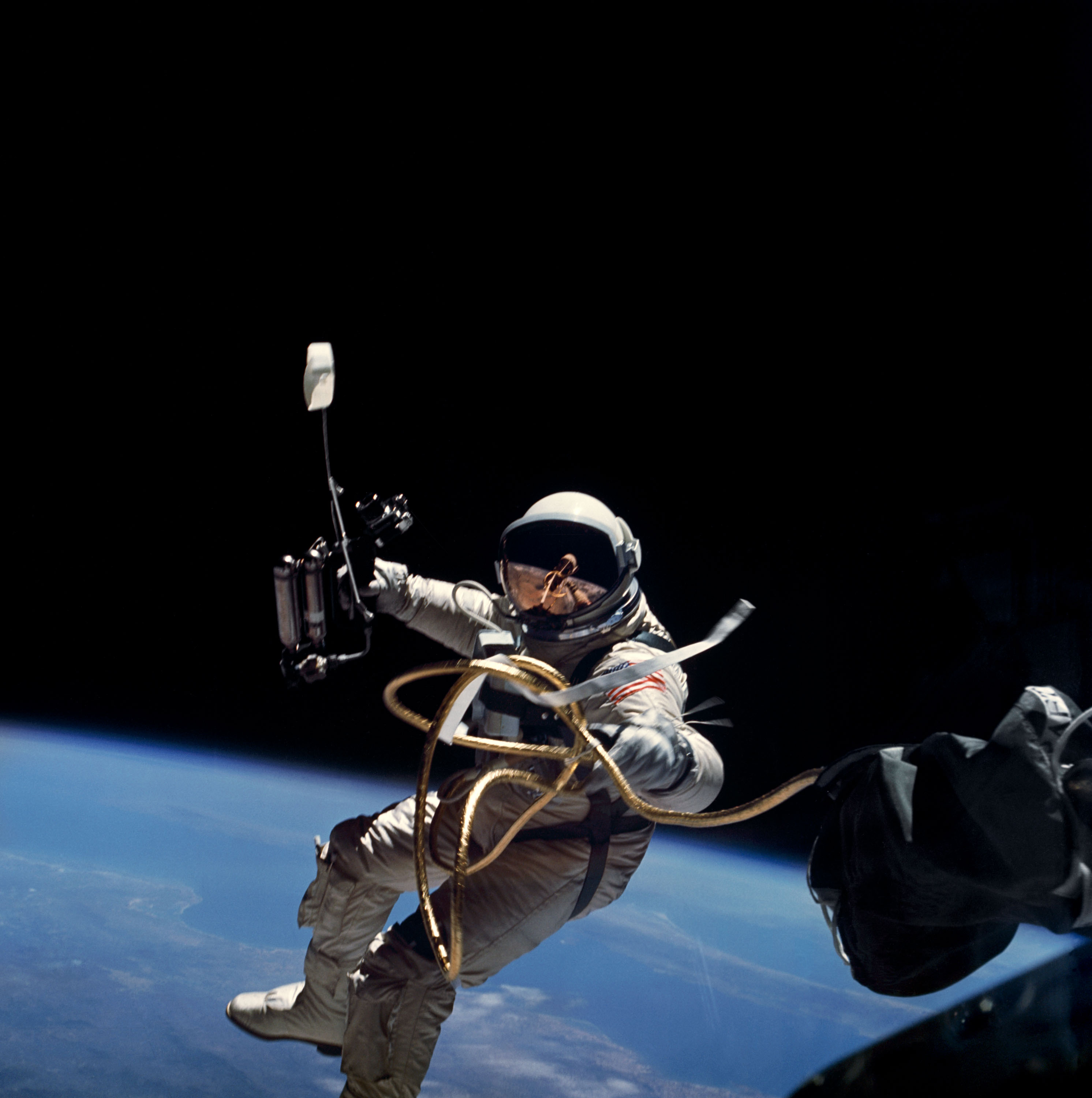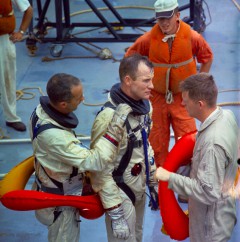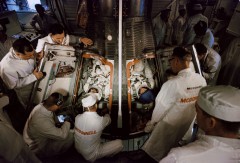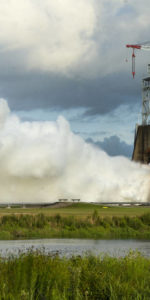
Exactly 50 years ago, in the first week of June 1965, the United States took a huge step forward in its drive to land a man on the Moon. Aboard Gemini IV, astronauts Jim McDivitt and Ed White spent four days in orbit—longer than any previous American crew—and supported their nation’s first Extravehicular Activity (EVA), or “spacewalk.” Neither accomplishment was a true “first” or an empirical record, for the Soviets had already performed their own EVA and achieved a five-day mission, but for a relieved America the mission offered tangible proof that the gap was closing and the late President John F. Kennedy’s goal of bootprints on the Moon before 1970 was in sight. McDivitt and White’s voyage is a case of being in the right place at the right time. When their names were announced in July 1964, Gemini Deputy Program Manager Kenneth Kleinknecht mentioned that one of them might perform a “stand-up EVA,” by opening the hatch and poking his head into the void of space. Yet it would take several months, and no small amount of lobbying by the astronauts themselves, before such plans bore fruit.
As early as January 1964, NASA had flagged Gemini IV as the earliest possible mission on which to perform some kind of EVA, although at the time the availability of the required life-support equipment was uncertain. Throughout the year, the situation steadily improved, with AiResearch building an astronaut’s chest-mounted control pack, the David Clark Company making the space suit and McDonnell modifying its Gemini spacecraft to accommodate an EVA. When Gemini sailed through altitude chamber tests in November, the likelihood of an EVA brightened significantly. Efforts gathered pace in the wake of Alexei Leonov’s March 1965 spacewalk, and in mid-May 1965 Bob Gilruth, head of the Manned Spacecraft Center (MSC) in Houston, Texas, received approval to proceed from NASA’s senior leaders, including Bob Seamans, Hugh Dryden, and Administrator Jim Webb.
There were concerns, however. George Mueller, the head of manned spaceflight, doubted that the EVA hardware could be ready in time for an early June launch, whilst Dryden was worried that the spacewalk might be seen as a knee-jerk reaction to Leonov’s achievement. At length, Webb asked Seamans to produce a report on why an EVA was necessary, and on 25 May—with nine days remaining before the flight—Dryden scribbled his signature of approval on it. By this time, NASA had referred to a “possible extravehicular activity” in its Gemini IV press kit, released on 21 May. With the approval of Webb and Dryden, it turned from possible into positive … and it would not be a simple case of Ed White standing on his seat to poke his helmeted head into space; he would physically leave Gemini IV and maneuver outside the spacecraft.

The two men destined to make history shared close parallels. Barely a year separated White and McDivitt in age, both were married to women named Pat, both earned aeronautical engineering degrees from the same institution, and, in the same year, both completed test pilot training at Edwards Air Force Base, Calif., and both had secured approximately the same amount (around 2,000 hours) of jet experience. In September 1962, both were chosen as members of NASA’s second astronaut class. “Jim and I have been following right along together,” White once said. “It seems that every time we got together we were taking examinations of some kind.” The “exam” on Gemini IV would be their most difficult and challenging so far.
When the Gemini mission simulator became available in Houston in November 1964, the pair began actively lobbying for an EVA on their mission. It has been remarked that, without McDivitt and White’s tenacity, the “G4C” EVA space suit might otherwise have been too far down the line to have been ready for Gemini IV. According to Barton Hacker and James Grimwood, writing in On the Shoulders of Titans in 1977, the astronauts’ role in the decision-making process “went far beyond that of the normal test pilot in determining what was to be done and when.” Still, when the EVA plan was unveiled, some observers felt that it was little more than a ploy to keep up with the Soviet Union and others simply did not realize that spacewalking had always been a primary goal for Project Gemini.
Another primary goal was to increase endurance times, with a crew spending up to two weeks in orbit, to provide physiological and psychological data for a maximum-length journey to the Moon and back. As part of this goal, Gemini IV was originally scheduled to fly for seven days, but in August 1964 it was announced that problems and delays with certifying General Electric’s long-duration fuel cells would reduce it to four days. Before launch, McDivitt jokingly told journalists that there was only enough food aboard the spacecraft “for two normal people” for four days. Backup crewman Jim Lovell could not resist taking the bait; with perfect timing, he quipped: “And these two ain’t normal!”

For White—the son of a West Point graduate and Air Force major general—the values of self-discipline, persistence, and a single-minded determination to achieve his goals were ingrained in his character. “Flying was his birthright,” wrote Mary C. White in her biography of him, and the future astronaut first took the controls of an old T-6 trainer with his father, aged 12. An excellent academic and athlete, White served on the Military Academy’s track team as a hurdler. In 1952, he narrowly missed selection (by just 0.4 seconds) to represent the United States in that year’s Olympic Games.
Right up until the end of his life, White pursued physical exercise with a passion: volleyball, handball, squash, and golf, together with daily long-distance jogging, bicycle riding and back-to-back marathons of sit-ups and press-ups. Doctors struggled to find the slightest hint of fat on him, and, it is said, his appetite was so voracious that he could put away two full-course dinners and ask for dessert, with a straight face. Without doubt, he was the most physically fit of all the astronauts … an attribute which would serve him well on his grueling EVA.
The second part of this article will appear tomorrow.
Want to keep up-to-date with all things space? Be sure to “Like” AmericaSpace on Facebook and follow us on Twitter: @AmericaSpace





As I recall, the Soviets protested and bitterly fought the inclusion Ed White’s space walk in the FAI Fédération Aéronautique Internationale record books.
Their claim? The Soviets insisted that to be considered for a “true” EVA in the record book, the astronaut (cosmonaut) had to have a life support system completely independent from the spacecraft, only a simple tether was allowed.
Ed White had gas supply umbilical line connecting his suit to the Gemini’s life support system, whereas Leonov had a true PLSS back pack.
This sort of stuff went on the time back in those days. It seems quite petty now, but back in the day spaceflight was viewed as an international sporting event of sorts, and the Russians were especially concerned about being the “first” or the “longest” or the “biggest” in the record books.